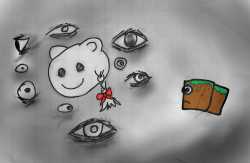
For anyone curious about tools used for decorative stuff since the terrain was initally only flat grass this morning
A giant ring of stone was first created using
> //g stone (0.8-sqrt(x^2+z^2))^4+y^4 < 0.08^2
basically testing every block in the selected area against this condition depending on x y z coordinates
the number minus square root allow for a giant horizonal donut to be be created
Then since it's just very artificial and flat as it, I apply another condition on it to make it looks like natural terrain with
>//replace =perlin(0,x/6,y/2,z/6,0.05,3,0.8)<0.034*y air
Perlin noise would be too long to explain here but it's a succession of randomness of different scales that make "random" looks more natural, the same thing used to by minecraft terrain generation more or less
Then
>//replace "air >stone" 40%grass_block,4%coarse_dirt,15%green_concrete_powder,5%dirt_path
to cover the stone with a layer of a random mix of "natural looking" material
Then
>//replace "air >grass_block" 20%air,15%grass,10%fern,5%##flowers
to replace the air on top of grass blocks with some grass, ferns and flowers
Then some manual adjustements here and there
Also for the giant flying donut, made this calculation :
>//g white_wool data=(32+15/2/pi*atan2(x,y))%16; (0.8-sqrt(x^2+y^2))^2+z^2 < 0.25^2
first part "data=(32+15/2/pi*atan2(x,y))%16" is the block data, wool that get colored depending on the Arctangent of the x/y position (so it's the same alongside the one axis left), modulo 16 as there are only 16 colors
the second part "(0.75-sqrt(x^2+y^2))^2+z^2 < 0.25^2" is a condition that allows the existence of not of the block testing the condition with the value gotten from x y z position, with some trigonometry knowledge to get that shape
Pretty fun stuff

